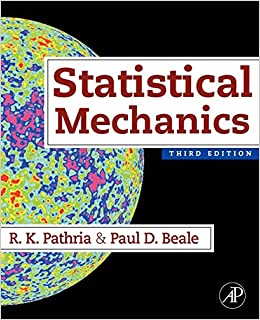We note that the symbol (mu_{0}(x N)) denotes the chemical potential ( (left.equiv k T ln z
Question:
We note that the symbol \(\mu_{0}(x N)\) denotes the chemical potential ( \(\left.\equiv k T \ln z \right)\) of an ideal gas of \(x N\) "spinless" \((g=1)\) fermions. The corresponding fugacity \(z\) is determined by the equation
\[
\begin{equation*}
f_{3 / 2}(z)=x N \lambda^{3} / V \tag{1}
\end{equation*}
\]
Differentiating (1) with respect to \(x\), we get
\[
\frac{\partial f_{3 / 2}(z)}{\partial \ln z} \frac{\partial \ln z}{\partial x}=\frac{N \lambda^{3}}{V}=\frac{1}{x} f_{3 / 2}(z) .
\]
It follows that
\[
\frac{\partial \mu_{0}}{\partial x}=\frac{k T}{x} \frac{f_{3 / 2}(z)}{f_{1 / 2}(z)}
\]
Equation (8.2.20) then assumes the form stated in the problem.
At low temperatures, we get
\[
\begin{align*}
\chi & =\frac{n \mu^{* 2}}{k T} \cdot \frac{3}{2 \ln z}\left\{1-\frac{\pi^{2}}{6}(\ln z)^{-2}+\ldots \right\} \\
& =\frac{3 n \mu^{* 2}}{2 \varepsilon_{F}}\left\{1-\frac{\pi^{2}}{12}\left(\frac{k T}{\varepsilon_{F}} \right)^{2}+\ldots \right\}^{-1}\left\{1-\frac{\pi^{2}}{6}\left(\frac{k T}{\varepsilon_{F}} \right)^{2}+\ldots \right\} \\
& \simeq \chi_{0}\left\{1-\frac{\pi^{2}}{12}\left(\frac{k T}{\varepsilon_{F}} \right)^{2} \right\} . \tag{8.2.24}
\end{align*}
\]
At high temperatures, on the other hand,
\[
\begin{align*}
\chi & =\frac{n \mu^{* 2}}{k T} \frac{z-2^{-1 / 2} z^{2}+\ldots}{z-2^{-3 / 2} z^{2}+\ldots}=\frac{n \mu^{* 2}}{k T}\left(1-2^{-3 / 2} z+\ldots \right) \\
& \simeq \chi_{\infty}\left(1-2^{-5 / 2} n \lambda^{3} \right) \tag{8.2.27}
\end{align*}
\]
where use has been made of eqn. (1), with \(f_{3 / 2}(z) \simeq z\) and \(x=1 / 2\).
Step by Step Answer:






